Financial Management Assessment Report - Analysis and Evaluation
VerifiedAdded on 2023/01/17
|13
|3511
|68
Report
AI Summary
This financial management assessment report delves into critical aspects of corporate finance, addressing long-term finance, particularly equity finance through right issues and scrip dividends. It includes detailed calculations and analyses of different scenarios, such as determining the number of shares to issue, theoretical ex-rights price assessment, and the computation of expected earnings per share (EPS). The report also evaluates the advantages and disadvantages of scrip dividends for companies and shareholders. Furthermore, the assessment explores investment appraisal techniques, including payback period, accounting rate of return (ARR), net present value (NPV), and internal rate of return (IRR), with detailed calculations and recommendations for a hypothetical company. The report concludes with a discussion of the benefits and limitations of each investment appraisal technique, providing a comprehensive overview of financial decision-making tools.
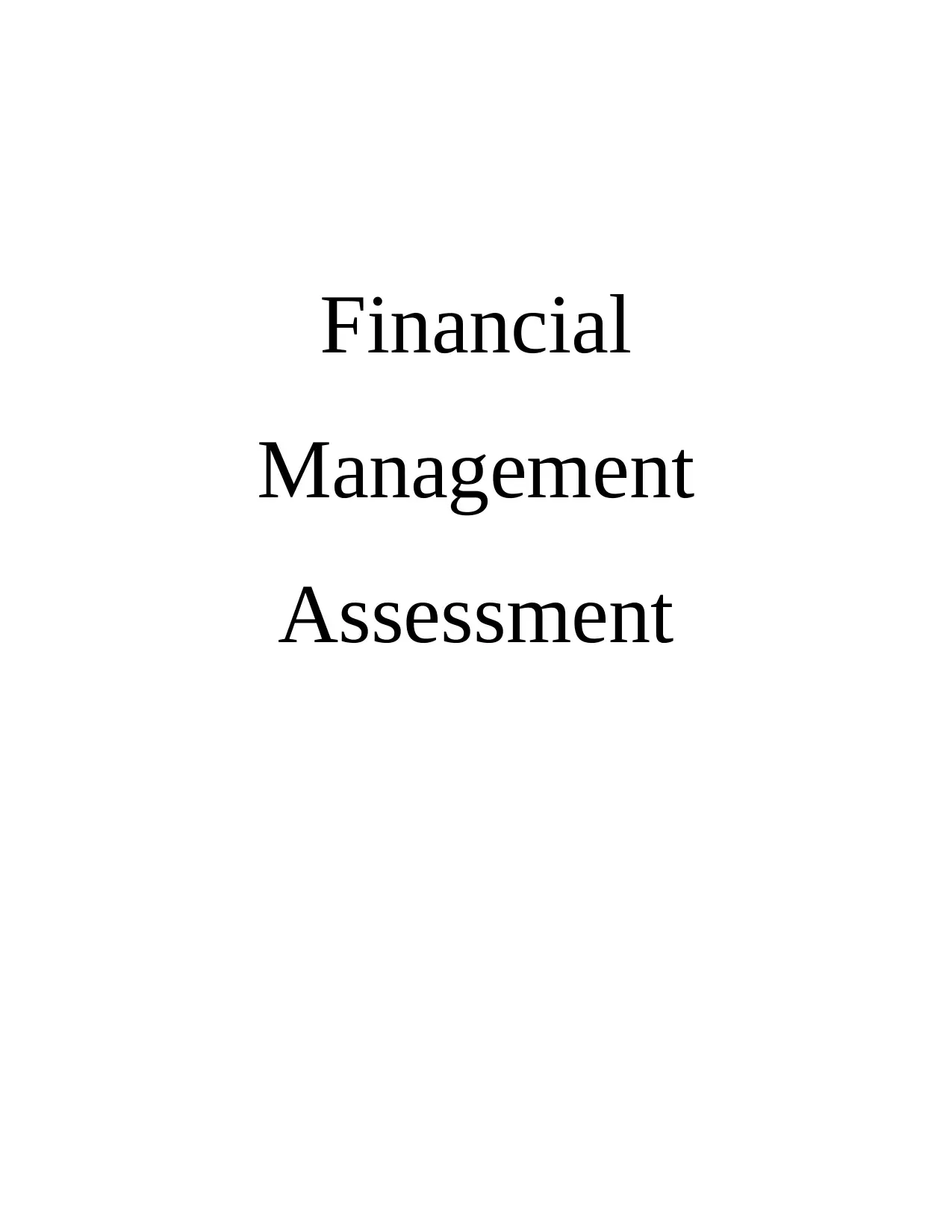
Financial
Management
Assessment
Management
Assessment
Paraphrase This Document
Need a fresh take? Get an instant paraphrase of this document with our AI Paraphraser
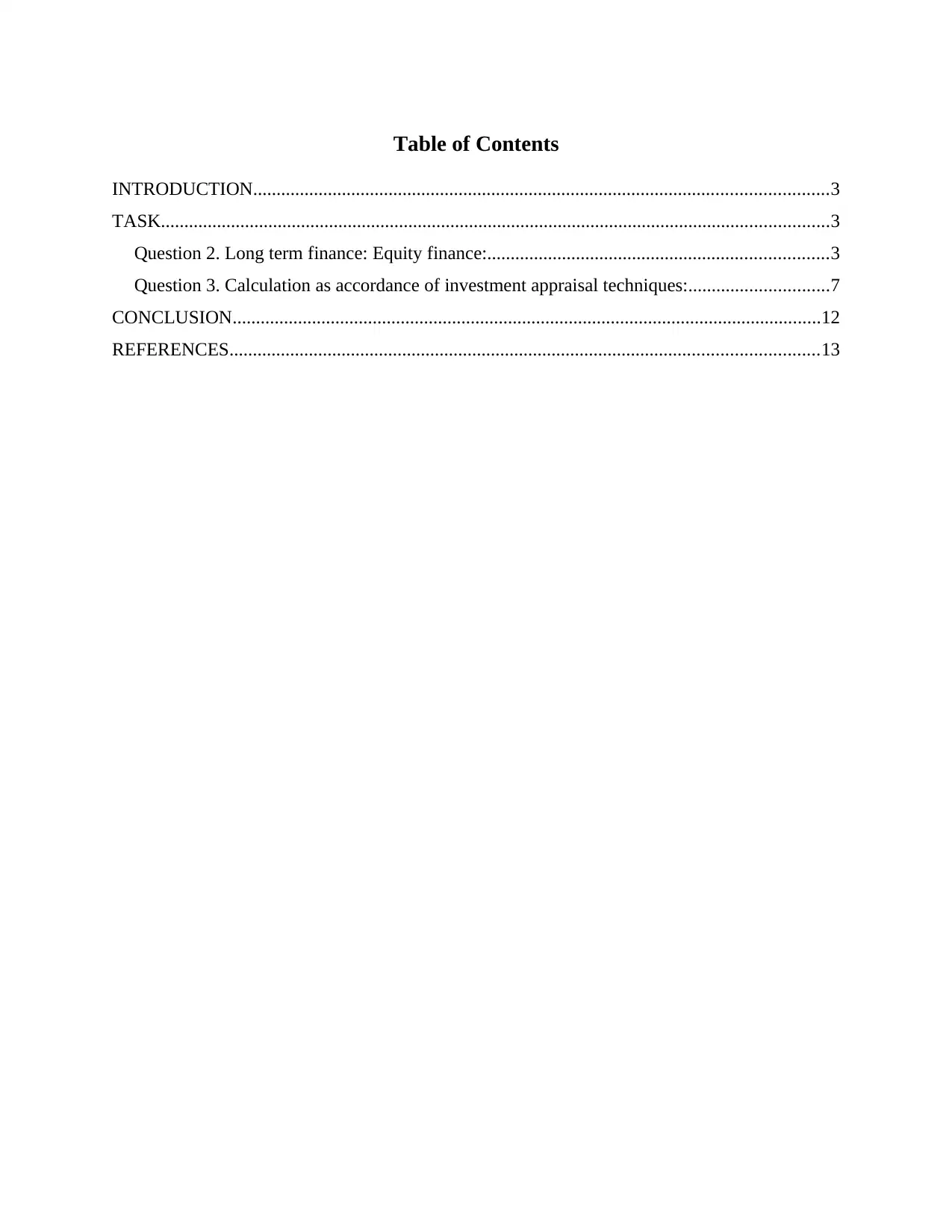
Table of Contents
INTRODUCTION...........................................................................................................................3
TASK...............................................................................................................................................3
Question 2. Long term finance: Equity finance:.........................................................................3
Question 3. Calculation as accordance of investment appraisal techniques:..............................7
CONCLUSION..............................................................................................................................12
REFERENCES..............................................................................................................................13
INTRODUCTION...........................................................................................................................3
TASK...............................................................................................................................................3
Question 2. Long term finance: Equity finance:.........................................................................3
Question 3. Calculation as accordance of investment appraisal techniques:..............................7
CONCLUSION..............................................................................................................................12
REFERENCES..............................................................................................................................13
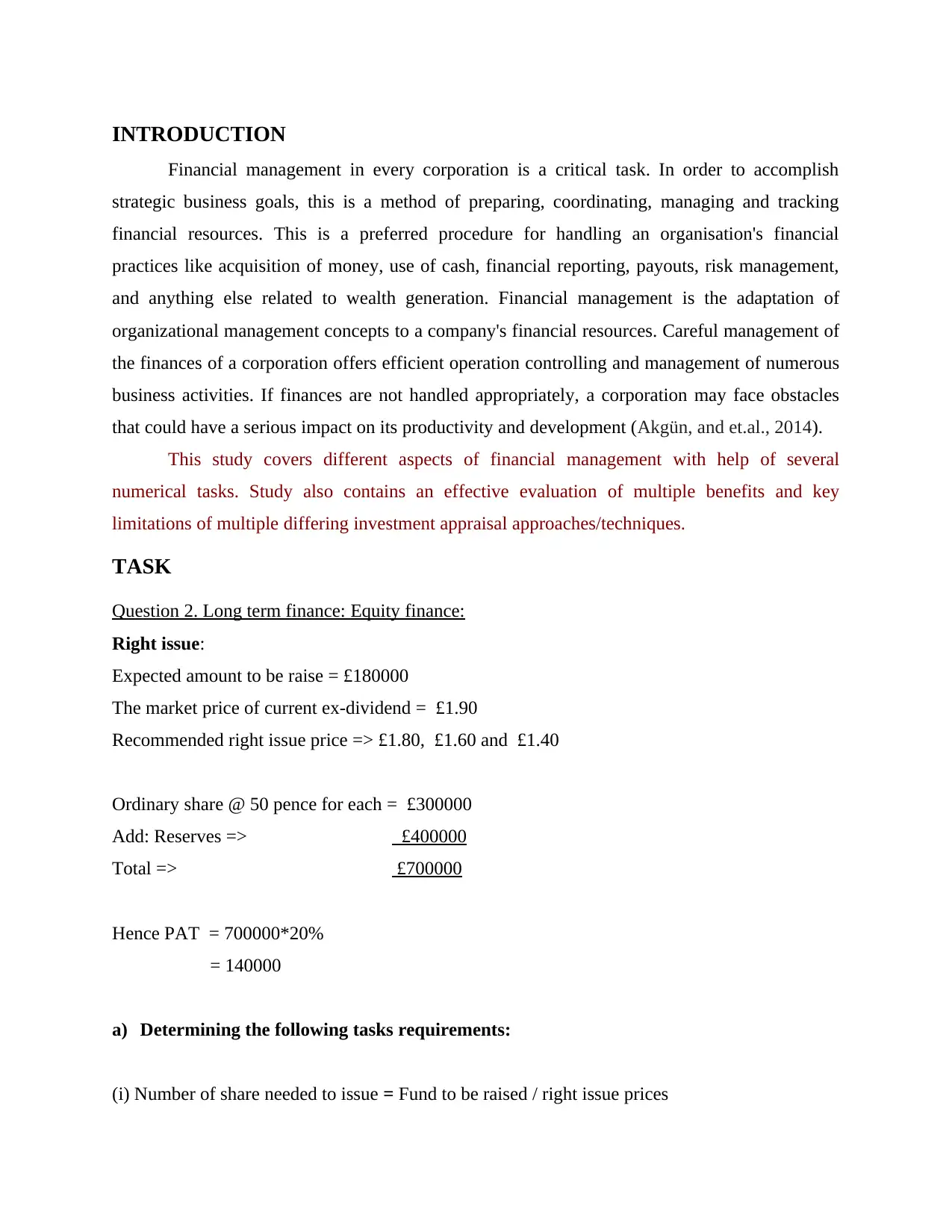
INTRODUCTION
Financial management in every corporation is a critical task. In order to accomplish
strategic business goals, this is a method of preparing, coordinating, managing and tracking
financial resources. This is a preferred procedure for handling an organisation's financial
practices like acquisition of money, use of cash, financial reporting, payouts, risk management,
and anything else related to wealth generation. Financial management is the adaptation of
organizational management concepts to a company's financial resources. Careful management of
the finances of a corporation offers efficient operation controlling and management of numerous
business activities. If finances are not handled appropriately, a corporation may face obstacles
that could have a serious impact on its productivity and development (Akgün, and et.al., 2014).
This study covers different aspects of financial management with help of several
numerical tasks. Study also contains an effective evaluation of multiple benefits and key
limitations of multiple differing investment appraisal approaches/techniques.
TASK
Question 2. Long term finance: Equity finance:
Right issue:
Expected amount to be raise = £180000
The market price of current ex-dividend = £1.90
Recommended right issue price => £1.80, £1.60 and £1.40
Ordinary share @ 50 pence for each = £300000
Add: Reserves => £400000
Total => £700000
Hence PAT = 700000*20%
= 140000
a) Determining the following tasks requirements:
(i) Number of share needed to issue = Fund to be raised / right issue prices
Financial management in every corporation is a critical task. In order to accomplish
strategic business goals, this is a method of preparing, coordinating, managing and tracking
financial resources. This is a preferred procedure for handling an organisation's financial
practices like acquisition of money, use of cash, financial reporting, payouts, risk management,
and anything else related to wealth generation. Financial management is the adaptation of
organizational management concepts to a company's financial resources. Careful management of
the finances of a corporation offers efficient operation controlling and management of numerous
business activities. If finances are not handled appropriately, a corporation may face obstacles
that could have a serious impact on its productivity and development (Akgün, and et.al., 2014).
This study covers different aspects of financial management with help of several
numerical tasks. Study also contains an effective evaluation of multiple benefits and key
limitations of multiple differing investment appraisal approaches/techniques.
TASK
Question 2. Long term finance: Equity finance:
Right issue:
Expected amount to be raise = £180000
The market price of current ex-dividend = £1.90
Recommended right issue price => £1.80, £1.60 and £1.40
Ordinary share @ 50 pence for each = £300000
Add: Reserves => £400000
Total => £700000
Hence PAT = 700000*20%
= 140000
a) Determining the following tasks requirements:
(i) Number of share needed to issue = Fund to be raised / right issue prices
⊘ This is a preview!⊘
Do you want full access?
Subscribe today to unlock all pages.

Trusted by 1+ million students worldwide
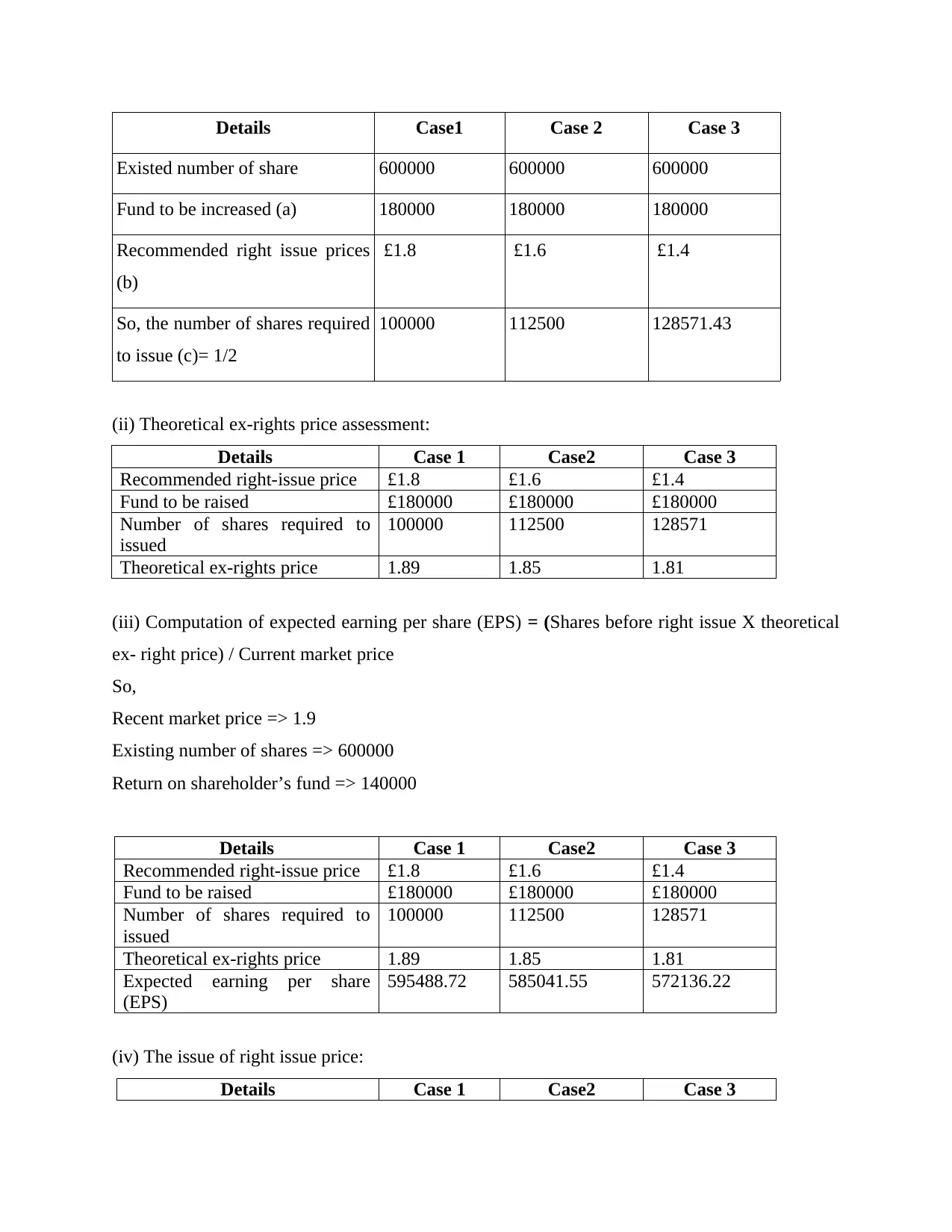
Details Case1 Case 2 Case 3
Existed number of share 600000 600000 600000
Fund to be increased (a) 180000 180000 180000
Recommended right issue prices
(b)
£1.8 £1.6 £1.4
So, the number of shares required
to issue (c)= 1/2
100000 112500 128571.43
(ii) Theoretical ex-rights price assessment:
Details Case 1 Case2 Case 3
Recommended right-issue price £1.8 £1.6 £1.4
Fund to be raised £180000 £180000 £180000
Number of shares required to
issued
100000 112500 128571
Theoretical ex-rights price 1.89 1.85 1.81
(iii) Computation of expected earning per share (EPS) = (Shares before right issue X theoretical
ex- right price) / Current market price
So,
Recent market price => 1.9
Existing number of shares => 600000
Return on shareholder’s fund => 140000
Details Case 1 Case2 Case 3
Recommended right-issue price £1.8 £1.6 £1.4
Fund to be raised £180000 £180000 £180000
Number of shares required to
issued
100000 112500 128571
Theoretical ex-rights price 1.89 1.85 1.81
Expected earning per share
(EPS)
595488.72 585041.55 572136.22
(iv) The issue of right issue price:
Details Case 1 Case2 Case 3
Existed number of share 600000 600000 600000
Fund to be increased (a) 180000 180000 180000
Recommended right issue prices
(b)
£1.8 £1.6 £1.4
So, the number of shares required
to issue (c)= 1/2
100000 112500 128571.43
(ii) Theoretical ex-rights price assessment:
Details Case 1 Case2 Case 3
Recommended right-issue price £1.8 £1.6 £1.4
Fund to be raised £180000 £180000 £180000
Number of shares required to
issued
100000 112500 128571
Theoretical ex-rights price 1.89 1.85 1.81
(iii) Computation of expected earning per share (EPS) = (Shares before right issue X theoretical
ex- right price) / Current market price
So,
Recent market price => 1.9
Existing number of shares => 600000
Return on shareholder’s fund => 140000
Details Case 1 Case2 Case 3
Recommended right-issue price £1.8 £1.6 £1.4
Fund to be raised £180000 £180000 £180000
Number of shares required to
issued
100000 112500 128571
Theoretical ex-rights price 1.89 1.85 1.81
Expected earning per share
(EPS)
595488.72 585041.55 572136.22
(iv) The issue of right issue price:
Details Case 1 Case2 Case 3
Paraphrase This Document
Need a fresh take? Get an instant paraphrase of this document with our AI Paraphraser
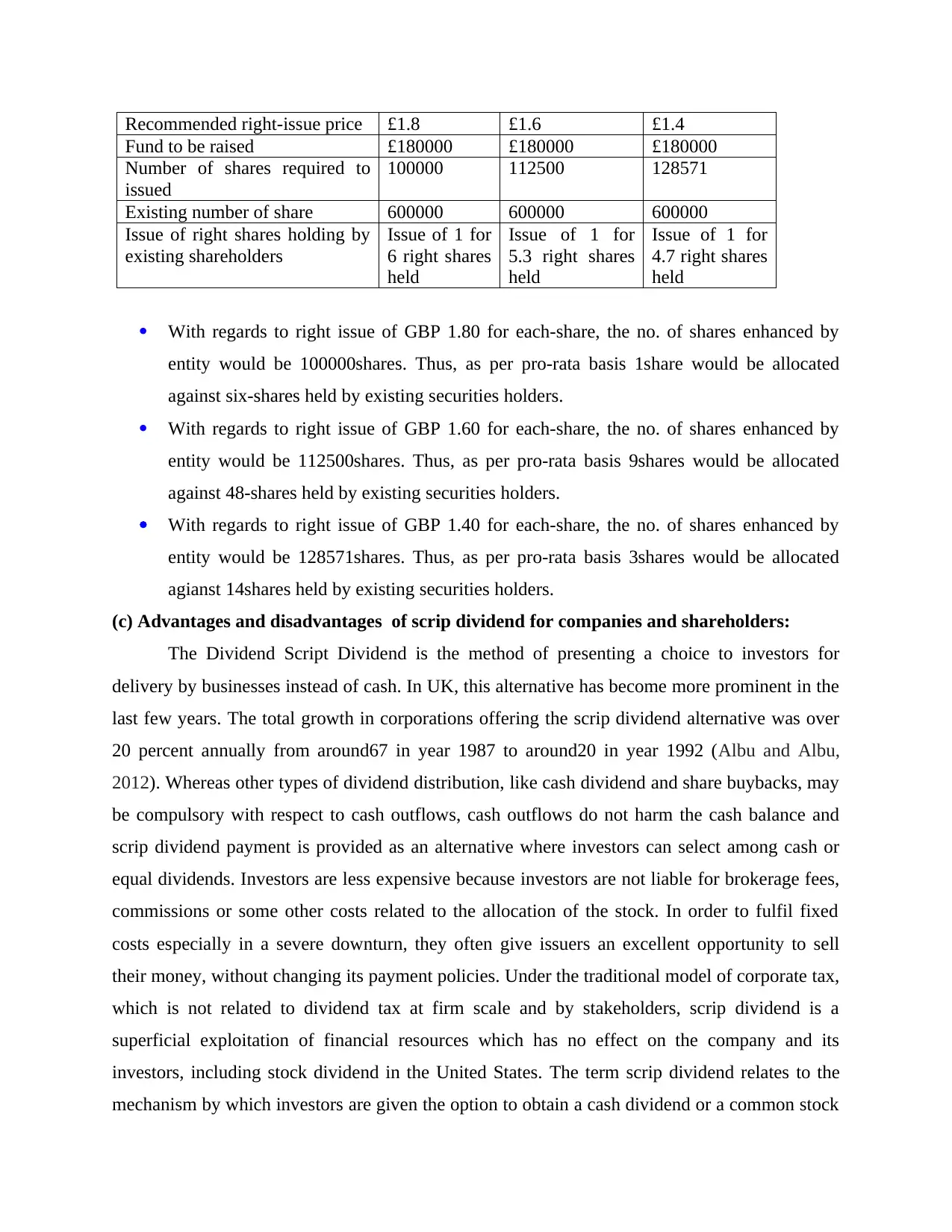
Recommended right-issue price £1.8 £1.6 £1.4
Fund to be raised £180000 £180000 £180000
Number of shares required to
issued
100000 112500 128571
Existing number of share 600000 600000 600000
Issue of right shares holding by
existing shareholders
Issue of 1 for
6 right shares
held
Issue of 1 for
5.3 right shares
held
Issue of 1 for
4.7 right shares
held
With regards to right issue of GBP 1.80 for each-share, the no. of shares enhanced by
entity would be 100000shares. Thus, as per pro-rata basis 1share would be allocated
against six-shares held by existing securities holders.
With regards to right issue of GBP 1.60 for each-share, the no. of shares enhanced by
entity would be 112500shares. Thus, as per pro-rata basis 9shares would be allocated
against 48-shares held by existing securities holders.
With regards to right issue of GBP 1.40 for each-share, the no. of shares enhanced by
entity would be 128571shares. Thus, as per pro-rata basis 3shares would be allocated
agianst 14shares held by existing securities holders.
(c) Advantages and disadvantages of scrip dividend for companies and shareholders:
The Dividend Script Dividend is the method of presenting a choice to investors for
delivery by businesses instead of cash. In UK, this alternative has become more prominent in the
last few years. The total growth in corporations offering the scrip dividend alternative was over
20 percent annually from around67 in year 1987 to around20 in year 1992 (Albu and Albu,
2012). Whereas other types of dividend distribution, like cash dividend and share buybacks, may
be compulsory with respect to cash outflows, cash outflows do not harm the cash balance and
scrip dividend payment is provided as an alternative where investors can select among cash or
equal dividends. Investors are less expensive because investors are not liable for brokerage fees,
commissions or some other costs related to the allocation of the stock. In order to fulfil fixed
costs especially in a severe downturn, they often give issuers an excellent opportunity to sell
their money, without changing its payment policies. Under the traditional model of corporate tax,
which is not related to dividend tax at firm scale and by stakeholders, scrip dividend is a
superficial exploitation of financial resources which has no effect on the company and its
investors, including stock dividend in the United States. The term scrip dividend relates to the
mechanism by which investors are given the option to obtain a cash dividend or a common stock
Fund to be raised £180000 £180000 £180000
Number of shares required to
issued
100000 112500 128571
Existing number of share 600000 600000 600000
Issue of right shares holding by
existing shareholders
Issue of 1 for
6 right shares
held
Issue of 1 for
5.3 right shares
held
Issue of 1 for
4.7 right shares
held
With regards to right issue of GBP 1.80 for each-share, the no. of shares enhanced by
entity would be 100000shares. Thus, as per pro-rata basis 1share would be allocated
against six-shares held by existing securities holders.
With regards to right issue of GBP 1.60 for each-share, the no. of shares enhanced by
entity would be 112500shares. Thus, as per pro-rata basis 9shares would be allocated
against 48-shares held by existing securities holders.
With regards to right issue of GBP 1.40 for each-share, the no. of shares enhanced by
entity would be 128571shares. Thus, as per pro-rata basis 3shares would be allocated
agianst 14shares held by existing securities holders.
(c) Advantages and disadvantages of scrip dividend for companies and shareholders:
The Dividend Script Dividend is the method of presenting a choice to investors for
delivery by businesses instead of cash. In UK, this alternative has become more prominent in the
last few years. The total growth in corporations offering the scrip dividend alternative was over
20 percent annually from around67 in year 1987 to around20 in year 1992 (Albu and Albu,
2012). Whereas other types of dividend distribution, like cash dividend and share buybacks, may
be compulsory with respect to cash outflows, cash outflows do not harm the cash balance and
scrip dividend payment is provided as an alternative where investors can select among cash or
equal dividends. Investors are less expensive because investors are not liable for brokerage fees,
commissions or some other costs related to the allocation of the stock. In order to fulfil fixed
costs especially in a severe downturn, they often give issuers an excellent opportunity to sell
their money, without changing its payment policies. Under the traditional model of corporate tax,
which is not related to dividend tax at firm scale and by stakeholders, scrip dividend is a
superficial exploitation of financial resources which has no effect on the company and its
investors, including stock dividend in the United States. The term scrip dividend relates to the
mechanism by which investors are given the option to obtain a cash dividend or a common stock
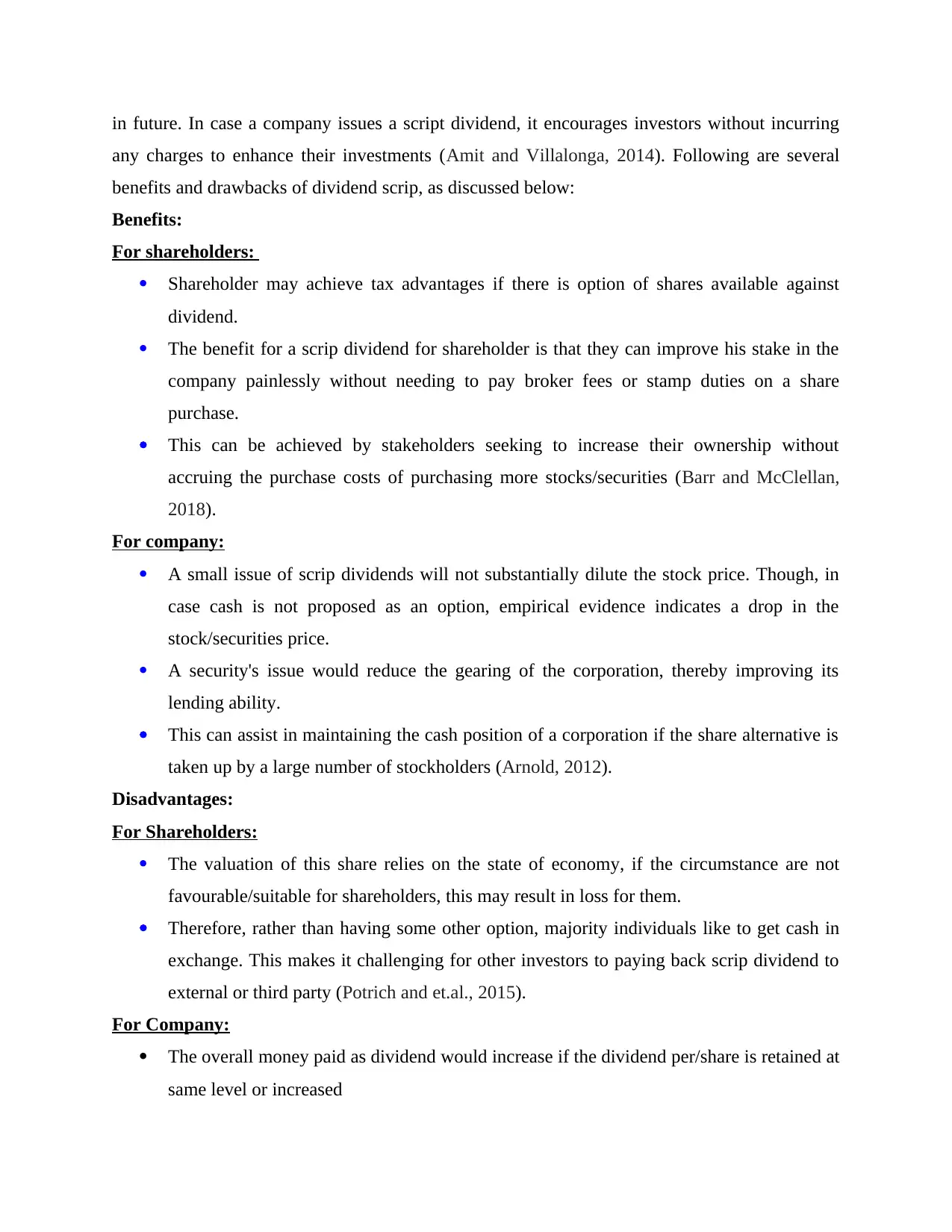
in future. In case a company issues a script dividend, it encourages investors without incurring
any charges to enhance their investments (Amit and Villalonga, 2014). Following are several
benefits and drawbacks of dividend scrip, as discussed below:
Benefits:
For shareholders:
Shareholder may achieve tax advantages if there is option of shares available against
dividend.
The benefit for a scrip dividend for shareholder is that they can improve his stake in the
company painlessly without needing to pay broker fees or stamp duties on a share
purchase.
This can be achieved by stakeholders seeking to increase their ownership without
accruing the purchase costs of purchasing more stocks/securities (Barr and McClellan,
2018).
For company:
A small issue of scrip dividends will not substantially dilute the stock price. Though, in
case cash is not proposed as an option, empirical evidence indicates a drop in the
stock/securities price.
A security's issue would reduce the gearing of the corporation, thereby improving its
lending ability.
This can assist in maintaining the cash position of a corporation if the share alternative is
taken up by a large number of stockholders (Arnold, 2012).
Disadvantages:
For Shareholders:
The valuation of this share relies on the state of economy, if the circumstance are not
favourable/suitable for shareholders, this may result in loss for them.
Therefore, rather than having some other option, majority individuals like to get cash in
exchange. This makes it challenging for other investors to paying back scrip dividend to
external or third party (Potrich and et.al., 2015).
For Company:
The overall money paid as dividend would increase if the dividend per/share is retained at
same level or increased
any charges to enhance their investments (Amit and Villalonga, 2014). Following are several
benefits and drawbacks of dividend scrip, as discussed below:
Benefits:
For shareholders:
Shareholder may achieve tax advantages if there is option of shares available against
dividend.
The benefit for a scrip dividend for shareholder is that they can improve his stake in the
company painlessly without needing to pay broker fees or stamp duties on a share
purchase.
This can be achieved by stakeholders seeking to increase their ownership without
accruing the purchase costs of purchasing more stocks/securities (Barr and McClellan,
2018).
For company:
A small issue of scrip dividends will not substantially dilute the stock price. Though, in
case cash is not proposed as an option, empirical evidence indicates a drop in the
stock/securities price.
A security's issue would reduce the gearing of the corporation, thereby improving its
lending ability.
This can assist in maintaining the cash position of a corporation if the share alternative is
taken up by a large number of stockholders (Arnold, 2012).
Disadvantages:
For Shareholders:
The valuation of this share relies on the state of economy, if the circumstance are not
favourable/suitable for shareholders, this may result in loss for them.
Therefore, rather than having some other option, majority individuals like to get cash in
exchange. This makes it challenging for other investors to paying back scrip dividend to
external or third party (Potrich and et.al., 2015).
For Company:
The overall money paid as dividend would increase if the dividend per/share is retained at
same level or increased
⊘ This is a preview!⊘
Do you want full access?
Subscribe today to unlock all pages.

Trusted by 1+ million students worldwide
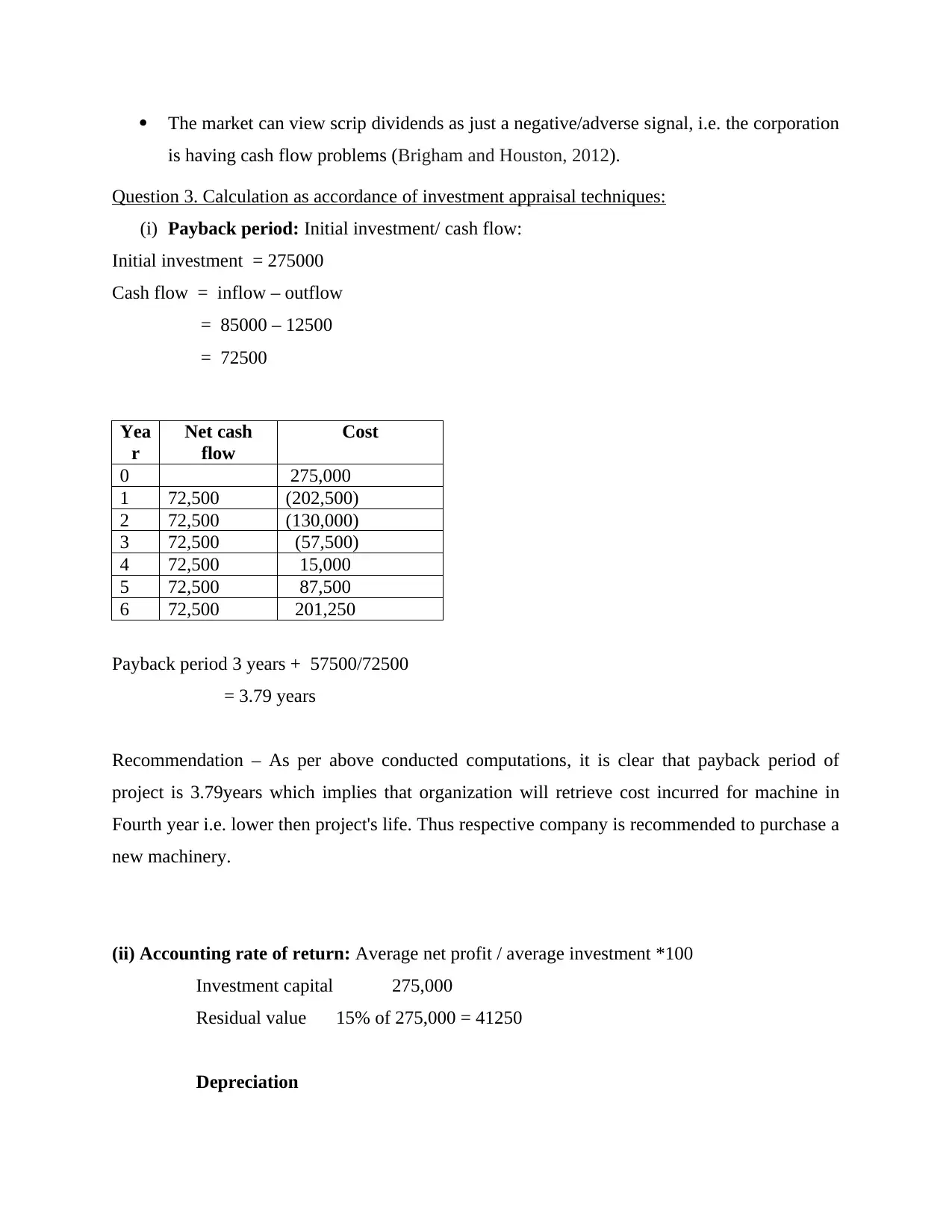
The market can view scrip dividends as just a negative/adverse signal, i.e. the corporation
is having cash flow problems (Brigham and Houston, 2012).
Question 3. Calculation as accordance of investment appraisal techniques:
(i) Payback period: Initial investment/ cash flow:
Initial investment = 275000
Cash flow = inflow – outflow
= 85000 – 12500
= 72500
Yea
r
Net cash
flow
Cost
0 275,000
1 72,500 (202,500)
2 72,500 (130,000)
3 72,500 (57,500)
4 72,500 15,000
5 72,500 87,500
6 72,500 201,250
Payback period 3 years + 57500/72500
= 3.79 years
Recommendation – As per above conducted computations, it is clear that payback period of
project is 3.79years which implies that organization will retrieve cost incurred for machine in
Fourth year i.e. lower then project's life. Thus respective company is recommended to purchase a
new machinery.
(ii) Accounting rate of return: Average net profit / average investment *100
Investment capital 275,000
Residual value 15% of 275,000 = 41250
Depreciation
is having cash flow problems (Brigham and Houston, 2012).
Question 3. Calculation as accordance of investment appraisal techniques:
(i) Payback period: Initial investment/ cash flow:
Initial investment = 275000
Cash flow = inflow – outflow
= 85000 – 12500
= 72500
Yea
r
Net cash
flow
Cost
0 275,000
1 72,500 (202,500)
2 72,500 (130,000)
3 72,500 (57,500)
4 72,500 15,000
5 72,500 87,500
6 72,500 201,250
Payback period 3 years + 57500/72500
= 3.79 years
Recommendation – As per above conducted computations, it is clear that payback period of
project is 3.79years which implies that organization will retrieve cost incurred for machine in
Fourth year i.e. lower then project's life. Thus respective company is recommended to purchase a
new machinery.
(ii) Accounting rate of return: Average net profit / average investment *100
Investment capital 275,000
Residual value 15% of 275,000 = 41250
Depreciation
Paraphrase This Document
Need a fresh take? Get an instant paraphrase of this document with our AI Paraphraser
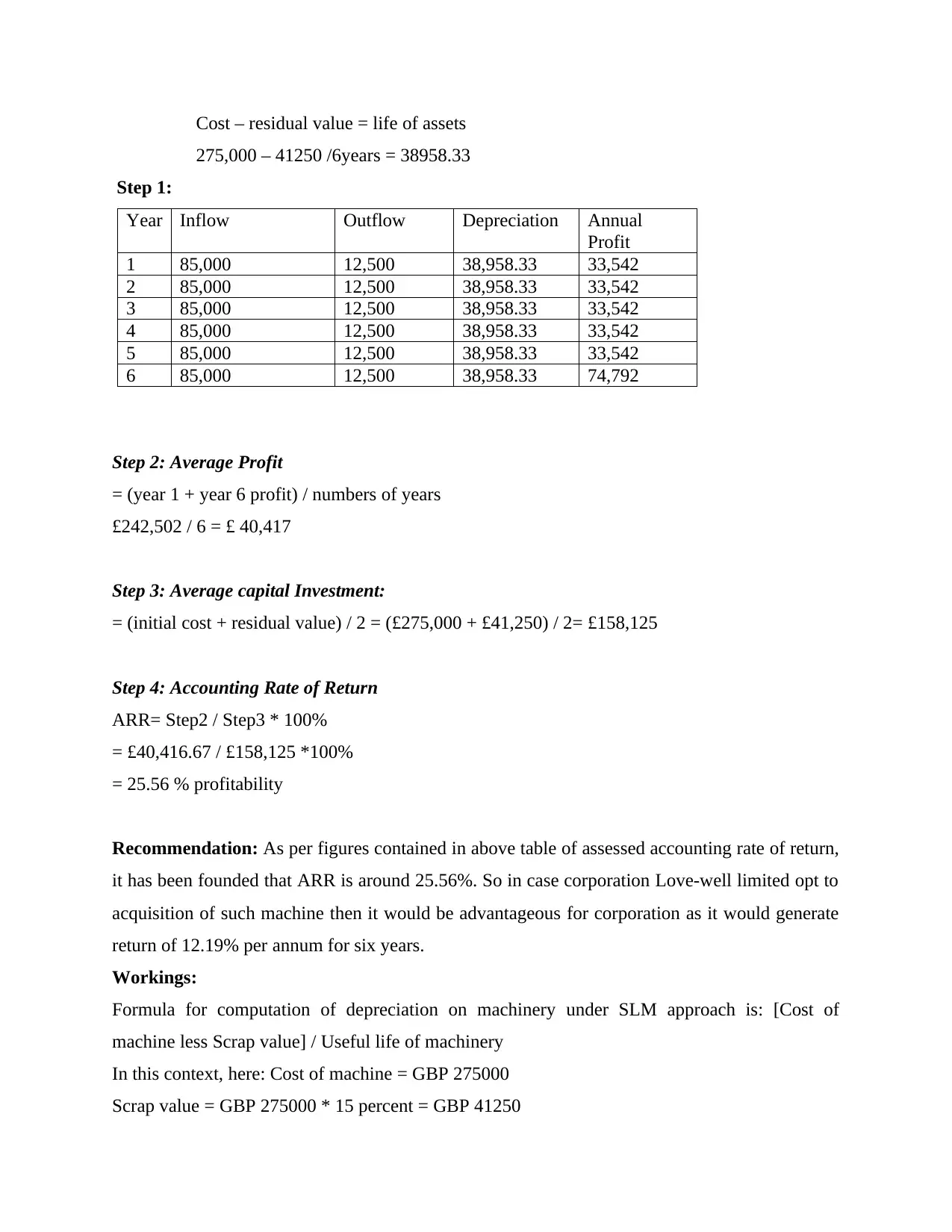
Cost – residual value = life of assets
275,000 – 41250 /6years = 38958.33
Step 1:
Year Inflow Outflow Depreciation Annual
Profit
1 85,000 12,500 38,958.33 33,542
2 85,000 12,500 38,958.33 33,542
3 85,000 12,500 38,958.33 33,542
4 85,000 12,500 38,958.33 33,542
5 85,000 12,500 38,958.33 33,542
6 85,000 12,500 38,958.33 74,792
Step 2: Average Profit
= (year 1 + year 6 profit) / numbers of years
£242,502 / 6 = £ 40,417
Step 3: Average capital Investment:
= (initial cost + residual value) / 2 = (£275,000 + £41,250) / 2= £158,125
Step 4: Accounting Rate of Return
ARR= Step2 / Step3 * 100%
= £40,416.67 / £158,125 *100%
= 25.56 % profitability
Recommendation: As per figures contained in above table of assessed accounting rate of return,
it has been founded that ARR is around 25.56%. So in case corporation Love-well limited opt to
acquisition of such machine then it would be advantageous for corporation as it would generate
return of 12.19% per annum for six years.
Workings:
Formula for computation of depreciation on machinery under SLM approach is: [Cost of
machine less Scrap value] / Useful life of machinery
In this context, here: Cost of machine = GBP 275000
Scrap value = GBP 275000 * 15 percent = GBP 41250
275,000 – 41250 /6years = 38958.33
Step 1:
Year Inflow Outflow Depreciation Annual
Profit
1 85,000 12,500 38,958.33 33,542
2 85,000 12,500 38,958.33 33,542
3 85,000 12,500 38,958.33 33,542
4 85,000 12,500 38,958.33 33,542
5 85,000 12,500 38,958.33 33,542
6 85,000 12,500 38,958.33 74,792
Step 2: Average Profit
= (year 1 + year 6 profit) / numbers of years
£242,502 / 6 = £ 40,417
Step 3: Average capital Investment:
= (initial cost + residual value) / 2 = (£275,000 + £41,250) / 2= £158,125
Step 4: Accounting Rate of Return
ARR= Step2 / Step3 * 100%
= £40,416.67 / £158,125 *100%
= 25.56 % profitability
Recommendation: As per figures contained in above table of assessed accounting rate of return,
it has been founded that ARR is around 25.56%. So in case corporation Love-well limited opt to
acquisition of such machine then it would be advantageous for corporation as it would generate
return of 12.19% per annum for six years.
Workings:
Formula for computation of depreciation on machinery under SLM approach is: [Cost of
machine less Scrap value] / Useful life of machinery
In this context, here: Cost of machine = GBP 275000
Scrap value = GBP 275000 * 15 percent = GBP 41250
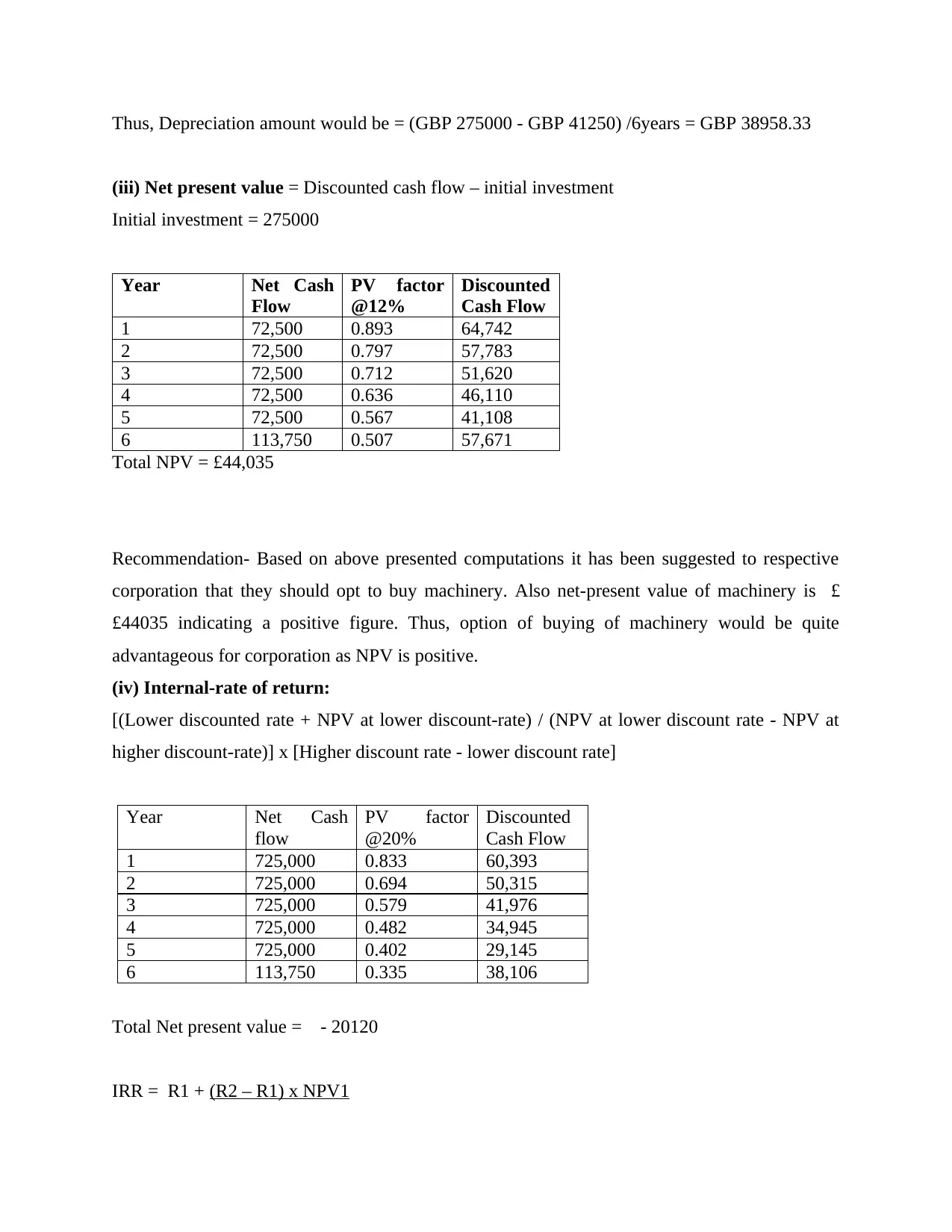
Thus, Depreciation amount would be = (GBP 275000 - GBP 41250) /6years = GBP 38958.33
(iii) Net present value = Discounted cash flow – initial investment
Initial investment = 275000
Year Net Cash
Flow
PV factor
@12%
Discounted
Cash Flow
1 72,500 0.893 64,742
2 72,500 0.797 57,783
3 72,500 0.712 51,620
4 72,500 0.636 46,110
5 72,500 0.567 41,108
6 113,750 0.507 57,671
Total NPV = £44,035
Recommendation- Based on above presented computations it has been suggested to respective
corporation that they should opt to buy machinery. Also net-present value of machinery is £
£44035 indicating a positive figure. Thus, option of buying of machinery would be quite
advantageous for corporation as NPV is positive.
(iv) Internal-rate of return:
[(Lower discounted rate + NPV at lower discount-rate) / (NPV at lower discount rate - NPV at
higher discount-rate)] x [Higher discount rate - lower discount rate]
Year Net Cash
flow
PV factor
@20%
Discounted
Cash Flow
1 725,000 0.833 60,393
2 725,000 0.694 50,315
3 725,000 0.579 41,976
4 725,000 0.482 34,945
5 725,000 0.402 29,145
6 113,750 0.335 38,106
Total Net present value = - 20120
IRR = R1 + (R2 – R1) x NPV1
(iii) Net present value = Discounted cash flow – initial investment
Initial investment = 275000
Year Net Cash
Flow
PV factor
@12%
Discounted
Cash Flow
1 72,500 0.893 64,742
2 72,500 0.797 57,783
3 72,500 0.712 51,620
4 72,500 0.636 46,110
5 72,500 0.567 41,108
6 113,750 0.507 57,671
Total NPV = £44,035
Recommendation- Based on above presented computations it has been suggested to respective
corporation that they should opt to buy machinery. Also net-present value of machinery is £
£44035 indicating a positive figure. Thus, option of buying of machinery would be quite
advantageous for corporation as NPV is positive.
(iv) Internal-rate of return:
[(Lower discounted rate + NPV at lower discount-rate) / (NPV at lower discount rate - NPV at
higher discount-rate)] x [Higher discount rate - lower discount rate]
Year Net Cash
flow
PV factor
@20%
Discounted
Cash Flow
1 725,000 0.833 60,393
2 725,000 0.694 50,315
3 725,000 0.579 41,976
4 725,000 0.482 34,945
5 725,000 0.402 29,145
6 113,750 0.335 38,106
Total Net present value = - 20120
IRR = R1 + (R2 – R1) x NPV1
⊘ This is a preview!⊘
Do you want full access?
Subscribe today to unlock all pages.

Trusted by 1+ million students worldwide
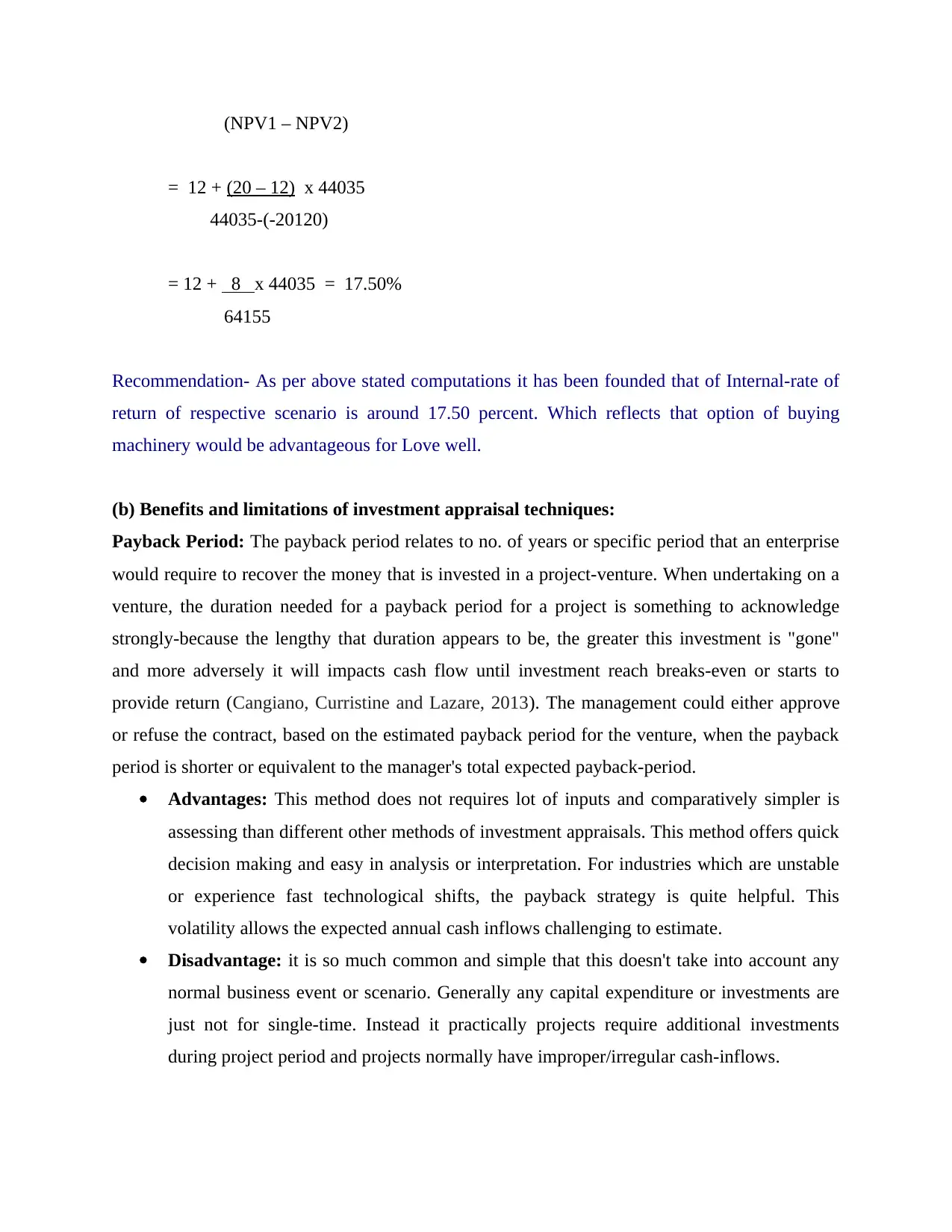
(NPV1 – NPV2)
= 12 + (20 – 12) x 44035
44035-(-20120)
= 12 + 8 x 44035 = 17.50%
64155
Recommendation- As per above stated computations it has been founded that of Internal-rate of
return of respective scenario is around 17.50 percent. Which reflects that option of buying
machinery would be advantageous for Love well.
(b) Benefits and limitations of investment appraisal techniques:
Payback Period: The payback period relates to no. of years or specific period that an enterprise
would require to recover the money that is invested in a project-venture. When undertaking on a
venture, the duration needed for a payback period for a project is something to acknowledge
strongly-because the lengthy that duration appears to be, the greater this investment is "gone"
and more adversely it will impacts cash flow until investment reach breaks-even or starts to
provide return (Cangiano, Curristine and Lazare, 2013). The management could either approve
or refuse the contract, based on the estimated payback period for the venture, when the payback
period is shorter or equivalent to the manager's total expected payback-period.
Advantages: This method does not requires lot of inputs and comparatively simpler is
assessing than different other methods of investment appraisals. This method offers quick
decision making and easy in analysis or interpretation. For industries which are unstable
or experience fast technological shifts, the payback strategy is quite helpful. This
volatility allows the expected annual cash inflows challenging to estimate.
Disadvantage: it is so much common and simple that this doesn't take into account any
normal business event or scenario. Generally any capital expenditure or investments are
just not for single-time. Instead it practically projects require additional investments
during project period and projects normally have improper/irregular cash-inflows.
= 12 + (20 – 12) x 44035
44035-(-20120)
= 12 + 8 x 44035 = 17.50%
64155
Recommendation- As per above stated computations it has been founded that of Internal-rate of
return of respective scenario is around 17.50 percent. Which reflects that option of buying
machinery would be advantageous for Love well.
(b) Benefits and limitations of investment appraisal techniques:
Payback Period: The payback period relates to no. of years or specific period that an enterprise
would require to recover the money that is invested in a project-venture. When undertaking on a
venture, the duration needed for a payback period for a project is something to acknowledge
strongly-because the lengthy that duration appears to be, the greater this investment is "gone"
and more adversely it will impacts cash flow until investment reach breaks-even or starts to
provide return (Cangiano, Curristine and Lazare, 2013). The management could either approve
or refuse the contract, based on the estimated payback period for the venture, when the payback
period is shorter or equivalent to the manager's total expected payback-period.
Advantages: This method does not requires lot of inputs and comparatively simpler is
assessing than different other methods of investment appraisals. This method offers quick
decision making and easy in analysis or interpretation. For industries which are unstable
or experience fast technological shifts, the payback strategy is quite helpful. This
volatility allows the expected annual cash inflows challenging to estimate.
Disadvantage: it is so much common and simple that this doesn't take into account any
normal business event or scenario. Generally any capital expenditure or investments are
just not for single-time. Instead it practically projects require additional investments
during project period and projects normally have improper/irregular cash-inflows.
Paraphrase This Document
Need a fresh take? Get an instant paraphrase of this document with our AI Paraphraser
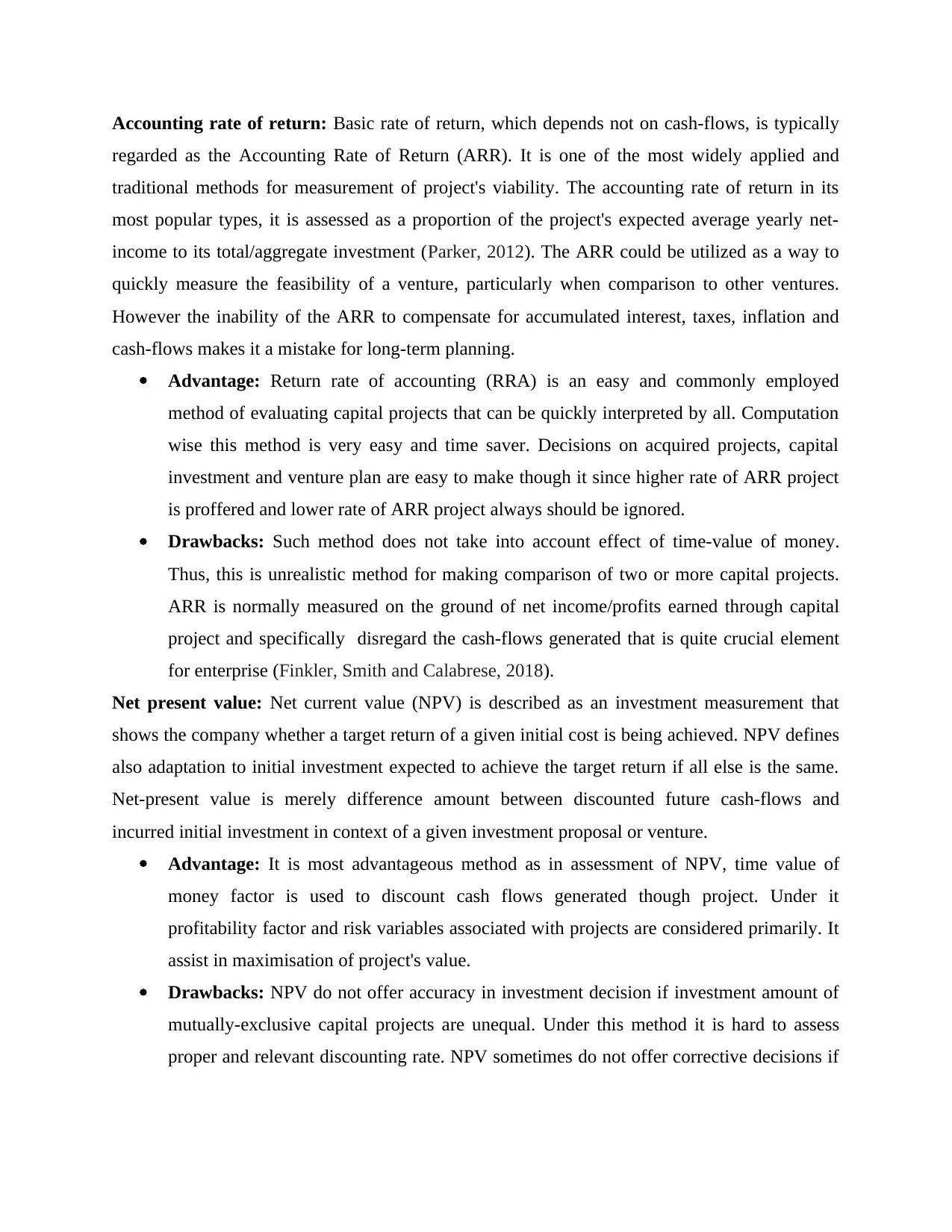
Accounting rate of return: Basic rate of return, which depends not on cash-flows, is typically
regarded as the Accounting Rate of Return (ARR). It is one of the most widely applied and
traditional methods for measurement of project's viability. The accounting rate of return in its
most popular types, it is assessed as a proportion of the project's expected average yearly net-
income to its total/aggregate investment (Parker, 2012). The ARR could be utilized as a way to
quickly measure the feasibility of a venture, particularly when comparison to other ventures.
However the inability of the ARR to compensate for accumulated interest, taxes, inflation and
cash-flows makes it a mistake for long-term planning.
Advantage: Return rate of accounting (RRA) is an easy and commonly employed
method of evaluating capital projects that can be quickly interpreted by all. Computation
wise this method is very easy and time saver. Decisions on acquired projects, capital
investment and venture plan are easy to make though it since higher rate of ARR project
is proffered and lower rate of ARR project always should be ignored.
Drawbacks: Such method does not take into account effect of time-value of money.
Thus, this is unrealistic method for making comparison of two or more capital projects.
ARR is normally measured on the ground of net income/profits earned through capital
project and specifically disregard the cash-flows generated that is quite crucial element
for enterprise (Finkler, Smith and Calabrese, 2018).
Net present value: Net current value (NPV) is described as an investment measurement that
shows the company whether a target return of a given initial cost is being achieved. NPV defines
also adaptation to initial investment expected to achieve the target return if all else is the same.
Net-present value is merely difference amount between discounted future cash-flows and
incurred initial investment in context of a given investment proposal or venture.
Advantage: It is most advantageous method as in assessment of NPV, time value of
money factor is used to discount cash flows generated though project. Under it
profitability factor and risk variables associated with projects are considered primarily. It
assist in maximisation of project's value.
Drawbacks: NPV do not offer accuracy in investment decision if investment amount of
mutually-exclusive capital projects are unequal. Under this method it is hard to assess
proper and relevant discounting rate. NPV sometimes do not offer corrective decisions if
regarded as the Accounting Rate of Return (ARR). It is one of the most widely applied and
traditional methods for measurement of project's viability. The accounting rate of return in its
most popular types, it is assessed as a proportion of the project's expected average yearly net-
income to its total/aggregate investment (Parker, 2012). The ARR could be utilized as a way to
quickly measure the feasibility of a venture, particularly when comparison to other ventures.
However the inability of the ARR to compensate for accumulated interest, taxes, inflation and
cash-flows makes it a mistake for long-term planning.
Advantage: Return rate of accounting (RRA) is an easy and commonly employed
method of evaluating capital projects that can be quickly interpreted by all. Computation
wise this method is very easy and time saver. Decisions on acquired projects, capital
investment and venture plan are easy to make though it since higher rate of ARR project
is proffered and lower rate of ARR project always should be ignored.
Drawbacks: Such method does not take into account effect of time-value of money.
Thus, this is unrealistic method for making comparison of two or more capital projects.
ARR is normally measured on the ground of net income/profits earned through capital
project and specifically disregard the cash-flows generated that is quite crucial element
for enterprise (Finkler, Smith and Calabrese, 2018).
Net present value: Net current value (NPV) is described as an investment measurement that
shows the company whether a target return of a given initial cost is being achieved. NPV defines
also adaptation to initial investment expected to achieve the target return if all else is the same.
Net-present value is merely difference amount between discounted future cash-flows and
incurred initial investment in context of a given investment proposal or venture.
Advantage: It is most advantageous method as in assessment of NPV, time value of
money factor is used to discount cash flows generated though project. Under it
profitability factor and risk variables associated with projects are considered primarily. It
assist in maximisation of project's value.
Drawbacks: NPV do not offer accuracy in investment decision if investment amount of
mutually-exclusive capital projects are unequal. Under this method it is hard to assess
proper and relevant discounting rate. NPV sometimes do not offer corrective decisions if
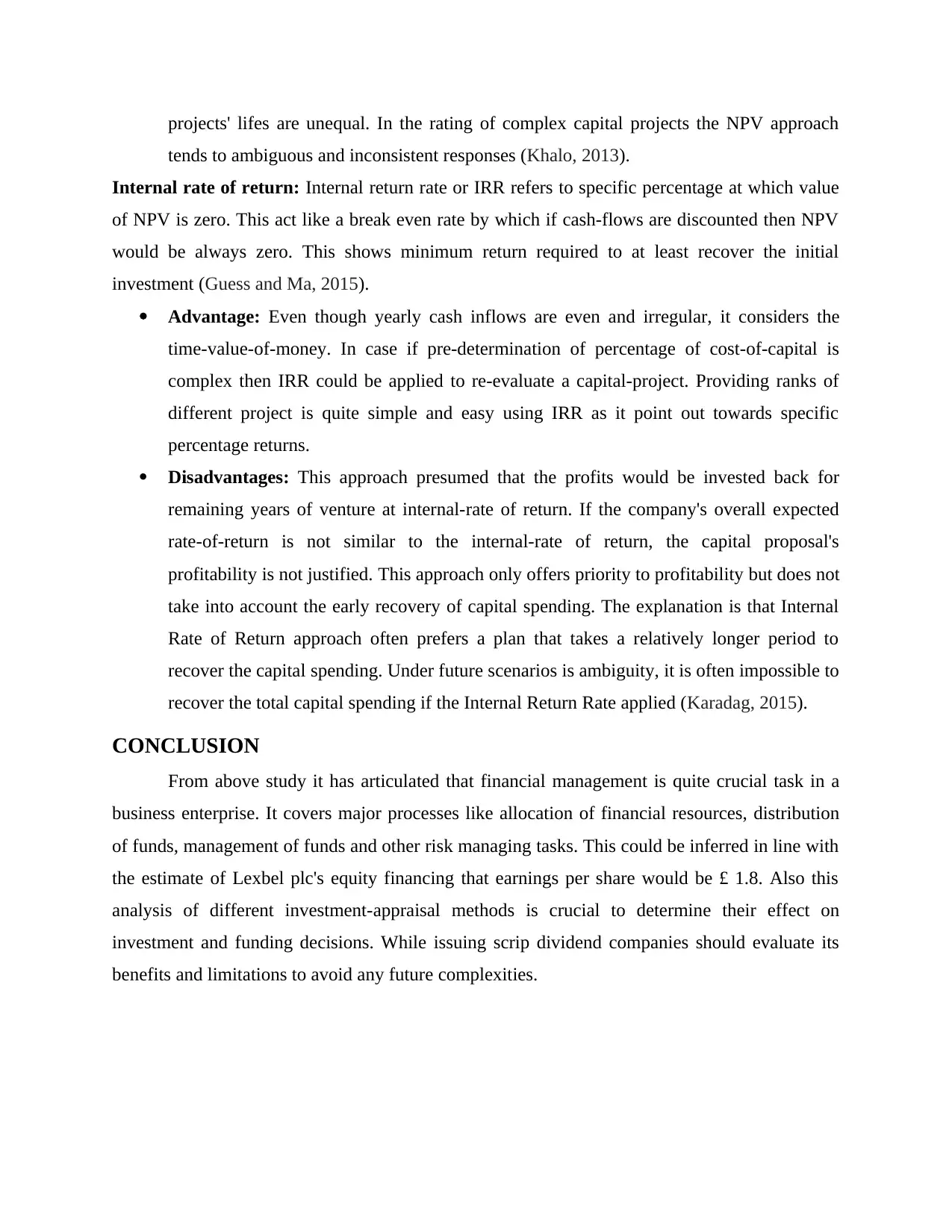
projects' lifes are unequal. In the rating of complex capital projects the NPV approach
tends to ambiguous and inconsistent responses (Khalo, 2013).
Internal rate of return: Internal return rate or IRR refers to specific percentage at which value
of NPV is zero. This act like a break even rate by which if cash-flows are discounted then NPV
would be always zero. This shows minimum return required to at least recover the initial
investment (Guess and Ma, 2015).
Advantage: Even though yearly cash inflows are even and irregular, it considers the
time-value-of-money. In case if pre-determination of percentage of cost-of-capital is
complex then IRR could be applied to re-evaluate a capital-project. Providing ranks of
different project is quite simple and easy using IRR as it point out towards specific
percentage returns.
Disadvantages: This approach presumed that the profits would be invested back for
remaining years of venture at internal-rate of return. If the company's overall expected
rate-of-return is not similar to the internal-rate of return, the capital proposal's
profitability is not justified. This approach only offers priority to profitability but does not
take into account the early recovery of capital spending. The explanation is that Internal
Rate of Return approach often prefers a plan that takes a relatively longer period to
recover the capital spending. Under future scenarios is ambiguity, it is often impossible to
recover the total capital spending if the Internal Return Rate applied (Karadag, 2015).
CONCLUSION
From above study it has articulated that financial management is quite crucial task in a
business enterprise. It covers major processes like allocation of financial resources, distribution
of funds, management of funds and other risk managing tasks. This could be inferred in line with
the estimate of Lexbel plc's equity financing that earnings per share would be £ 1.8. Also this
analysis of different investment-appraisal methods is crucial to determine their effect on
investment and funding decisions. While issuing scrip dividend companies should evaluate its
benefits and limitations to avoid any future complexities.
tends to ambiguous and inconsistent responses (Khalo, 2013).
Internal rate of return: Internal return rate or IRR refers to specific percentage at which value
of NPV is zero. This act like a break even rate by which if cash-flows are discounted then NPV
would be always zero. This shows minimum return required to at least recover the initial
investment (Guess and Ma, 2015).
Advantage: Even though yearly cash inflows are even and irregular, it considers the
time-value-of-money. In case if pre-determination of percentage of cost-of-capital is
complex then IRR could be applied to re-evaluate a capital-project. Providing ranks of
different project is quite simple and easy using IRR as it point out towards specific
percentage returns.
Disadvantages: This approach presumed that the profits would be invested back for
remaining years of venture at internal-rate of return. If the company's overall expected
rate-of-return is not similar to the internal-rate of return, the capital proposal's
profitability is not justified. This approach only offers priority to profitability but does not
take into account the early recovery of capital spending. The explanation is that Internal
Rate of Return approach often prefers a plan that takes a relatively longer period to
recover the capital spending. Under future scenarios is ambiguity, it is often impossible to
recover the total capital spending if the Internal Return Rate applied (Karadag, 2015).
CONCLUSION
From above study it has articulated that financial management is quite crucial task in a
business enterprise. It covers major processes like allocation of financial resources, distribution
of funds, management of funds and other risk managing tasks. This could be inferred in line with
the estimate of Lexbel plc's equity financing that earnings per share would be £ 1.8. Also this
analysis of different investment-appraisal methods is crucial to determine their effect on
investment and funding decisions. While issuing scrip dividend companies should evaluate its
benefits and limitations to avoid any future complexities.
⊘ This is a preview!⊘
Do you want full access?
Subscribe today to unlock all pages.

Trusted by 1+ million students worldwide
1 out of 13
Related Documents
Your All-in-One AI-Powered Toolkit for Academic Success.
+13062052269
info@desklib.com
Available 24*7 on WhatsApp / Email
![[object Object]](/_next/static/media/star-bottom.7253800d.svg)
Unlock your academic potential
Copyright © 2020–2026 A2Z Services. All Rights Reserved. Developed and managed by ZUCOL.




